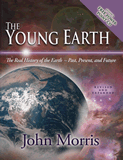
Montana Governor Attacks Creationists on the Age of the Earth
Just recently, Montana governor Brian Schweitzer criticized all young-earth creationists in a public gathering in Gallatin Gateway, Montana, four miles south of my house. He was dedicating a newly constructed pedestrian tunnel under the main highway for a group of schoolchildren, parents, and teachers. Noticing state representative Roger Koopman in the audience, he asked the crowd whether they believed the earth was hundreds of millions of years old. Unfortunately, most of the children raised their hand, either because they believed it or because of peer pressure. He then asked who believed the planet was less than a million years old. Few raised their hand.
One of those who did raise his hand was Koopman, who is running in a very tight race against a liberal Democrat. The governor later remarked that he did not need people in the legislature “who think the Earth is 4,000 years old.”1 He then went on to say that those who disbelieve the geological “evidence” are unfit to be legislators! This made front-page headlines in the local Bozeman, Montana, newspaper.
Not only was it inappropriate for the governor to attack a state representative at a public dedication, but he also insulted the beliefs of about half the people in this nation. Many opinion polls over the years have found that about half the population believes in young-earth creationism, about 40% believe in some form of theistic evolution, and only 10% are atheistic evolutionists. Koopman later made a reasonable defense of his position to the reporter. The article resulted in three critical letters to the editor and a long editorial by state senator Joe Balyeat in the Bozeman Chronicle.
Balyeat noted that under Schweitzer’s criteria, our founding fathers would be disqualified to serve in the Montana legislature because they clearly acknowledged the Creator. He summarized by saying that “intolerance and religious bigotry have no place in the public square, and certainly no place in our children’s schools.”2
But, notice how Montana’s anti-creationist governor attacked creationists. He used geology and the age of the earth—perceived weaknesses in creationist arguments. We need to take note of this and do more research and writing on these subjects. The subjective concepts of old age and uniformitarian geology started in the mid-1700s and 1800s, times when little was know about geology. These eventually led to the idea of evolution. Despite some scattered resistance, these three concepts have taken over the culture of the Western Hemisphere to its detriment and have greatly weakened the church by their attack on the authority of the Bible.3,4
No one believes the earth is 4,000 years old!
But like most critics of the Bible and creation, Governor Schweitzer demonstrated his ignorance on the issue when he said (assuming he was accurately quoted) that creationists believe the earth is 4,000 years old (later, in an interview, he said 4,000 to 6,000 years old). No one believes the earth is 4,000 years old! Adding up all the genealogies in Genesis 5, 10, and 11, the Bible says the earth is 6,000 years old. It would be good if these critics would first do their homework, educating themselves about what they criticize.
As far as old age and geological challenges, creationists are making great strides. There are a number of us who are bringing back the catastrophe of the Flood into earth history. The Flood was arbitrarily rejected for no good reason by people of the so-called Enlightenment. Bringing back the Flood into earth history will probably solve (or provide reasonable solutions for) about 80% of those time challenges, of which there are many.
For instance, while uniformitarian scientists claim that an ice age occurs very slowly and that there were around 30 of them in the last 2.5 million years, bringing back the Flood results in one short ice age of about 700 years.5,6 We do not need eons of time to explain the evidence for a post-Flood Ice Age.
Then there is the claim of ancient ice ages hundreds of millions to billions of years ago that lasted around a hundred million years in the uniformitarian timescale, based on supposed ice age features seen in the hard strata on the earth.7 These supposed ice age rocks can better be explained by gigantic landslides during the Genesis Flood.8
These are but two examples of answers to the numerous old age and geological challenges to the biblical creationist paradigm. The main issue in these challenges generally boils down to the interpretation of the data and the assumptions one brings to the data.
It is like attempting to figure out the origin of Grand Canyon. Those who believe the Colorado River eroded the canyon have trained their minds to see only a little water over long periods. There is no proof of this idea, and geologists constantly fail in their hypotheses.9 On the other hand, creationists believe that the Grand Canyon was formed by a lot of water over a short period of time. This is an equally valid starting point, if not more so.
And even the area of radiometric dating, considered accurate by the general public (due to years of evolutionary public education) is strongly being challenged by a number of creationists.10,11,12 The recent RATE (Radioisotopes and the Age of The Earth) project by the Institute for Creation Research and the Creation Research Society demonstrated that radiometric dates are wrong.13,14,15 For instance, radioactive zircon crystals in granite dated 1.5 billion years old by the uranium-lead method have been shown to have released only 6,000 years worth of helium, a byproduct of the radioactive decay. This much radiometric decay in only 6,000 years indicates a period of accelerated decay some time in the past. The official date of 1.5 billion years is incorrect for reasons that mainstream geologists have not considered in their radiometric dating assumptions.
Radioactive carbon-14 has commonly been measured in coal and diamonds, indicating that the earth is less than 100,000 years old! If a sample is older than 100,000 years, there should be no carbon-14 remaining. Contamination is the usual uniformitarian dodge, but how can a diamond be contaminated with outside carbon? Furthermore, such young carbon-14 dates in “old” carbon are more the rule than the exception!
The future looks bright for continued progress to meet earth science challenges from evolutionary/uniformitarian scientists and those, like Governor Schweitzer, who take evolutionists’ words by faith. There is enough information right now for one governor to learn that the geological evidence for an old earth is, at best, equivocal.
Footnotes
- Williams, W., 2006. Schweitzer Criticizes Koopman’s Beliefs. Bozeman Chronicle, October 7, p. A1.
- Balyeat, J., 2006. Guess Who Doesn’t Qualify as State Legislator. Bozeman Chronicle, October 14, p. A4.
- Mortenson, T., 2004. The Great Turning Point: The Church’s Catastrophic Mistake on Geology—Before Darwin, Master Books, Green Forest, Arkansas.
- Mortenson, T., 2006. The historical development of the old earth geological timescale. In, Reed, J. K. and M. J. Oard (editors), The Geological Column: Perspectives within Diluvial Geology, Creation Research Society Books, Chino Valley, Arizona, pp. 7–30.
- Oard, M. J., 1990. An Ice Age Caused by the Genesis Flood, Institute for Creation Research, El Cajon, California.
- Oard, M. J., 2004. Frozen in Time: The Woolly Mammoth, the Ice Age, and the Bible. Master Books, Green Forest, Arkansas.
- Crowell, J. C., 1999. Pre-Mesozoic Ice Ages: Their Bearing on Understanding the Climate System, Geological Society of America Memoir 192, Boulder, Colorado.
- Oard, M. J., 1997. Ancient Ice Ages or Gigantic Submarine Landslides? Creation Research Society Monograph No. 6, Chino Valley, AZ.
- Young, R. A. and E. E. Spamer (editors), 2001. Colorado River Origin and Evolution: Proceedings of a Symposium Held at Grand Canyon National Park in June, 2000, Grand Canyon Association, Grand Canyon, Arizona.
- Morris, J. D., 1994. The Young Earth, Master Books, Green Forest, Arkansas.
- Woodmorappe, J., 1999a. The Mythology of Modern Dating Methods, Institute for Creation Research, El Cajon, California.
- Woodmorappe, J., 1999b. Radiometric geochronology reappraised. In, Woodmorappe, J., Studies in Flood Geology—A Compilation of Research Studies Supporting Creation and the Flood, Institute for Creation Research, El Cajon, California, pp. 145–175.
- Vardiman, L., A. A. Snelling, and E. F. Chaffin (editors), 2000. Radioisotopes and the Age of the Earth—Volume 1, Institute for Creation Research and Creation Research Society, El Cajon, California, and Chino Valley, Arizona.
- Vardiman, L., A. A. Snelling, and E. F. Chaffin (editors), 2005. Radioisotopes and the Age of the Earth—Volume 2, Institute for Creation Research and Creation Research Society, El Cajon, California, and Chino Valley, Arizona.
- DeYoung, D., 2005. Thousands . . . Not Billions: Challenging an Icon of Evolution Questioning the Age of the Earth, Master Books, Green Forest, Arkansas.
Recommended Resources

Answers in Genesis is an apologetics ministry, dedicated to helping Christians defend their faith and proclaim the good news of Jesus Christ.
- Customer Service 800.778.3390
- Available Monday–Friday | 9 AM–5 PM ET
- © 2025 Answers in Genesis



